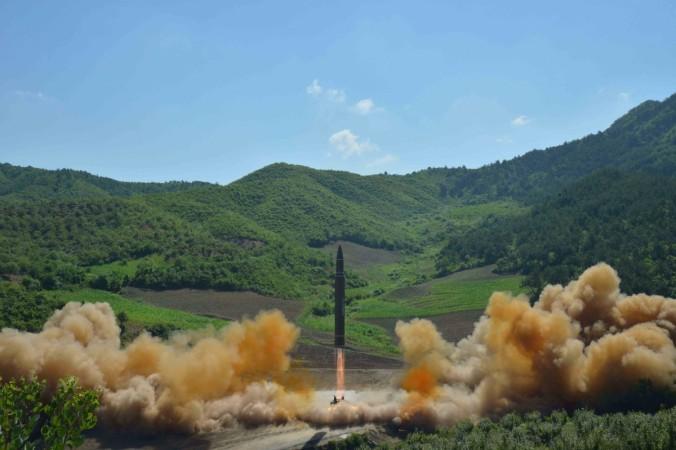Despite several international sanctions imposed on North Korea, the isolated nation on Wednesday once again tested an intercontinental ballistic missile (ICBM) — its most advanced so far — in an effort to pursue its nuclear weapons ambitions.
Pyongyang, on various occasions, has vowed to attack the United States if it feels threatened. The latest missile tests conducted by the country were capable of reaching the US Pacific territory of Guam.
The latest ICBM, which reached an altitude of 4,500 km and flew 960 km, landed close to Japan. The Japanese government said it flew for about 50 minutes and landed in the sea in Japan's economic zone.

Tensions between the US and North Korea have escalated as the leaders of the two countries have been locked in a bitter war of words over Pyongyang's ambitious nuclear programme. The situation worsened when US President Donald Trump, during his first address to the United Nations General Assembly (UNGA), vowed to annihilate North Korea if it posed any threat to the US and its allies.
Amidst the escalating tensions, it is probable that Pyongyang will launch a nuclear missile aimed at the United States. What happens then?
Dr Bruce Blair, former US nuclear launch officer and co-founder of Global Zero, said if North Korea launches a missile at the US or its allied territory, US satellites will immediately detect it and initiate the early stages of missile defence and nuclear retaliation protocols.
"If North Korea launches a missile aimed at US or allied territory, the fiery hot plume of the booster would be detected within one minute by US satellites equipped with heat detectors. This detection would initiate the early stage of the missile defence and the nuclear retaliation protocols," Blair told IBTimes India.
"Missile defence units in Alaska and California as well as abroad on allied territory (South Korea and Japan) and US (Aegis) destroyers will be quickly notified. Simultaneously, the emergency conference involving the head of Strategic Command (near Omaha), the president and his top advisers will begin," he added.

"Within a few minutes, two key ground radar sites in Alaska — one at the end of the Aleutian chain and one in Clear, Alaska — will detect and analyse the missile path, providing further cueing information to the missile defence units which would begin to prepare to launch their interceptors designed to hit the missile in the middle of its trajectory (the late 'up' phase and the early 'down' phase) and the terminal reentry phase in some cases," he explained.
"The US missile interceptors based in Alaska and California are assessed to have a 25 percent chance of a head-on collision with the attacking missile, but most experts believe the true performance to be much lower," said Blair.
The former nuclear launch officer further explained that soon the part of the missile would be confirmed and if its threatens North America then the "protocol for nuclear or non-nuclear retaliation will continue and a presidential decision on retaliation [will be] rendered within a few additional minutes."
He added: "Prior to the decision, the entire US military will be alerted and their readiness raised two notches to a level known as Defence Condition Two. (The only previous time this level has been reached was during the Cuban Missile Crisis of 1962.) Upon receipt of this notice, US forces will begin their preparations for retaliation and wait for the launch order."
Blair explained that two other plans will also begin during the emergency conference. These will include evacuation of the president and other important government leaders.
![North Korean leader Kim Jong Un provides guidance on a nuclear weapons program in this undated photo released by North Korea's Korean Central News Agency (KCNA) in Pyongyang September 3, 2017. [Representational Image] North Korea says it has developed 'advanced hydrogen bomb'](https://data1.ibtimes.co.in/en/full/660677/north-korea-says-it-has-developed-advanced-hydrogen-bomb.jpg?h=450&l=50&t=40)
"But during this emergency conference, two other emergency plans will be initiated. One is known as Continuity of Government. Its purpose is to ensure the safe evacuation of the President and other key government leaders as well as members of the Congress and many senior bureaucrats whose job is to ensure that the government continues to run under national direction. The only time that this plan has ever been initiated was on September 11, 2001, when the president was whisked away to Air Force bases in Louisiana and Nebraska.
"The other plan concerns homeland security, which will initiate civil defence plans (which has greatly atrophied since the end of the Cold War). The population will be warned by radio and TV with a special tone and from wailing sirens locally to shelter in place or at local emergency shelters. From an evacuation site, the president will probably try to address the nation on available commercial and other channels such as the emergency broadcast network (the way President Bush did on 9/11) and the national guard and other protection and policing functions will be activated," the former US nuclear launch officer said.
"Assuming a single or small nuclear missile strike, the civil defence effort will resemble a cross between Hurricane Katrina and Japan's Fukushima nuclear power plan disaster. First responders will be on the frontlines. Nuclear radiation and contamination will greatly complicate rescue and recovery effort, and in all likelihood overwhelm the few hospital units equipped to handle radiation sickness," he added.








